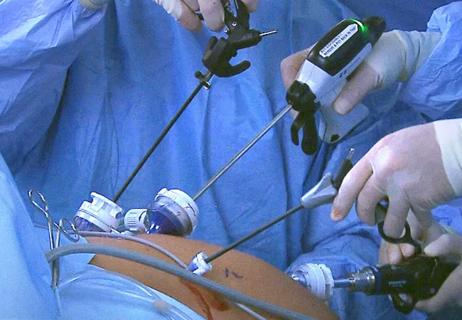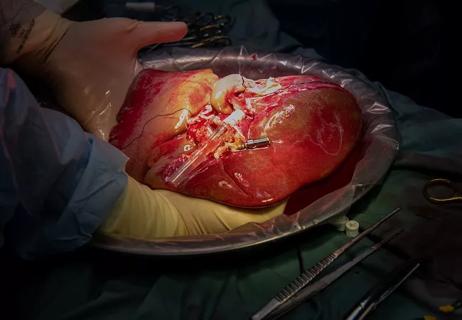Advertisement
Survey gauges caregivers’ knowledge, opinions about ‘full code’ requirements

To be eligible for liver transplantation, many transplant centers request that patients awaiting the potentially life-saving procedure consent to full resuscitation efforts in the event of cardiac or respiratory arrest before, during or after surgery.
Advertisement
Cleveland Clinic is a non-profit academic medical center. Advertising on our site helps support our mission. We do not endorse non-Cleveland Clinic products or services. Policy
The policy is meant to maximize the chances that scarce donor organs are used effectively.
A new study by Cleveland Clinic researchers reveals knowledge gaps among liver transplant providers about these institutional resuscitation policies, underscoring the importance of education surrounding end of life. The researchers’ findings also highlight the diversity of caregivers’ opinions about the expectation that transplant candidates and recipients consent to “full code,” and the need for more dialogue about when those resuscitation policies should be in effect.
“This study identifies that there is room for increased empathy, education, and an introspective look at our own ethos as transplant providers,” says study coauthor Christina Lindenmeyer, MD, a transplant hepatologist in Cleveland Clinic’s Department of Gastroenterology, Hepatology and Nutrition and Co-Director of the medical intensive liver unit (MILU).
The study results were presented at the American College of Gastroenterology’s 2022 annual meeting.
Liver transplantation is the only potentially curative option for patients with end-stage liver disease. These critically ill patients have high rates of in-hospital mortality and low rates of survival to discharge in cases where they undergo in-hospital cardiopulmonary resuscitation, says Dr. Lindenmeyer.
“There’s a fine line between intensive care for end-stage liver failure and the difficult decisions surrounding the risk associated with liver transplant. The goal of transplantation is to provide meaningful quality of life on the other side of transplant, and an opportunity for the patient to thrive. In some cases, especially in critically ill patients, the risk of dying while waiting for transplant is particularly high,” she says. “In the MILU, we prioritize patients’ wishes surrounding end of life because, essentially, the liver transplant waiting list is end of life, even though you’re looking forward to the light at the end of the tunnel.”
“Waitlist mortality is a reality, especially in critically ill patients with acute-on-chronic liver failure,” Dr. Lindenmeyer says. “An awareness of the patient’s relationship with life and death, even if the patient is considered to be a candidate for transplantation, is the hallmark of an educated and compassionate multidisciplinary liver transplant team.”
While Cleveland Clinic has no formal code status policy for transplant patients, Dr. Lindenmeyer says there is an expectation that patients on any solid organ transplant waiting list consent to full-code resuscitation, meaning chest compression, defibrillation and intubation. She notes that many transplant centers have full-code status requirements.
Advertisement
The rationale for such policies and protocols, she says, is “to ensure that the gift of life from the donor lives on.” If that involves heroic measures in the operating room or postoperatively, she explains, “these measures are enacted not only to save the life of the patient, but also to ensure the survival of the donor organ. This is an expectation that is frequently instituted pre-transplant.”
However, there is a growing school of thought that full-code requirements don’t necessarily make sense for patients prior to transplant.
“If a patient on the transplant list experiences cardiac arrest, they are more than likely not expected to have a good quality of life after a resuscitative effort,” Dr. Lindenmeyer says. “So practice is evolving to better respect that patients should be able to pass in the manner that best fits their end-of-life goals, irrespective of their status on an organ transplant waiting list.” Recognizing the importance of these issues, Dr. Lindenmeyer and her colleagues set out to assess Cleveland Clinic liver transplant providers’ awareness of organizational policies and their perspectives on code status protocols. The researchers’ intent was to use the results to provide care that aligns with their patients’ needs while also maintaining ethical organ allocation procedures for transplant.
Dr. Lindenmeyer and colleagues asked healthcare providers involved in liver transplantation at Cleveland Clinic’s high-volume transplant center to anonymously complete a 13-question survey about their perceptions of code status for patients with end-stage liver disease. Participants included gastroenterology/hepatology and critical care attending physicians and fellows, transplant surgeons, palliative medicine attending physicians, internal medicine residents, advanced practice providers, transplant coordinators, members of the transplant selection committee and social workers.
Advertisement
Among the 83 providers who took part in the survey, 40% reported that they either often or always discussed code status with patients. Sixty-two percent were unaware of the institutional protocol that patients must consent to full-code resuscitation to be evaluated for liver transplantation or to be listed on transplant registries. Additionally, 95% were unaware that the United Network for Organ Sharing, the organization that manages the nation’s organ transplant system, does not have a full-code requirement for patients on the national transplant waiting list.
The study authors found that 93% of the surveyed providers think patients undergoing liver transplantation evaluation should take part in a discussion of code status. When asked their opinion on code status policy for patients undergoing evaluation for liver transplant, 15% said patients should remain in full-code status throughout the process while 54% believed patients should have their choice of code status during evaluation and listing. Thirty-one percent of the surveyed providers said patients should have their choice during evaluation, but become full code once listed.
“Our study demonstrated a gap in knowledge that needs to be addressed,” Dr. Lindenmeyer says. “This is an opportunity for improvement and a chance to better educate our healthcare providers. While there is strong support for guiding our patients successfully to transplant, it’s important to recognize that there is a difference in the opportunity to thrive pre- and post-transplant. There are pathways to embrace end of life while also looking forward to transplant.”
In Cleveland Clinic’s MILU, which focuses on critically ill patients awaiting liver transplant, this is a top priority. “We have the opportunity to be better partners in our patients’ care,” Dr. Lindenmeyer says. “An improved understanding of the status of our own transplant culture will drive education for patients and their families. It will drive continuous improvement and patient satisfaction.
“The fine line between transplant and palliation is ever present,” she adds. “That’s one of our priorities in the MILU: to not only support patients to transplant but also to improve end-of-life care, which is something I think any liver transplant program can do better.”
Dr. Lindenmeyer hopes the survey results and her team’s ongoing work will lead to implementation of a quality improvement initiative at Cleveland Clinic — and potentially nationwide — to bridge the gap between palliation and critical care.
This could include developing novel educational initiatives for transplant team members, such as coordinated sessions between ICU and transplant personnel, Dr. Lindenmeyer says. Incorporating these discussions into the education provided to patients is also valuable. “This can help patients understand that we are walking this journey with them,” she says. “We want to be their allies.”
Advertisement
Advertisement

New research shows dramatic reduction in waitlist times with new technology

Program expands as data continues to show improved outcomes

Atypical cells discovered after primary sclerosing colongitis diagnosis

Research examines risk factors for mortality

Cleveland Clinic study finds that durable weight loss is key to health benefits

Findings could help promote organ preservation

A proof-of-concept study shows how 3D pouchography can be a useful adjunct for surgeons

Potential for new, non-invasive screening option